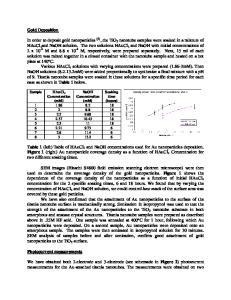Photoelectrochemical Properties of Highly-ordered Titania Nanotube-arrays
- PDF / 695,025 Bytes
- 6 Pages / 612 x 792 pts (letter) Page_size
- 89 Downloads / 298 Views
N3.13.1
Photoelectrochemical Properties of Highly-ordered Titania Nanotube-arrays Maggie Paulose, Oomman K. Varghese, Karthik Shankar, Gopal K. Mor, and Craig A. Grimes* Department of Electrical Engineering, Department of Materials Science and Engineering, and The Materials Research Institute, The Pennsylvania State University, University Park, PA 16802 USA. *Email:[email protected]
ABSTRACT We report on non-particulate titania photoelectrodes with a unique highly-ordered nanotube-array architecture prepared by an anodization process that enables precise control over array dimensions. Under 320–400 nm illumination titania nanotube-array photoanodes, pore size 110 nm, wall thickness 20 nm, and 6 µm length, generate hydrogen by water photoelectrolysis at a normalized rate of 80 mL/W•hr, to date the most efficient titania-based photoelectrochemical device, with a conversion efficiency of 12.25%. The highly-ordered nanotubular architecture allows for superior charge separation and charge transport, with a calculated quantum efficiency of nearly 100% for incident photons with energies larger than the titania bandgap. Keywords: Photolysis, titania, nanotube, water splitting, hydrogen. INTRODUCTION The development of a useful, cost-effective photochemically stable material system for water photoelectrolysis faces two fundamental material science challenges. One challenge, on which there have been many studies [1,2], is shifting of the materials absorption spectra from UV into the visible where the majority of the solar spectrum energy is resident. An equally important challenge which this work is concerned with, is that water photoelectrolysis requires a material architecture able to achieve efficient charge transfer so the photo-generated electrons and holes perform useful work splitting water, rather than simply recombining. To date the most efficient photoelectrochemical energy conversion devices have consisted of porous crystalline nanoparticulate titania films several microns thick [3-5] obtained by casting a colloidal sol, with a three dimensional network of interconnected 15-20 nm nanoparticles. While the large surface area of the porous nanoparticulate film enables efficient light harvesting and the electron-hole pairs generated by optical absorption are separated kinetically [6], the system efficiency is limited by the poor electron transport through the network [7]. Consequently ordered nanostructures such as arrays of nanowires [8], nanorods [9,10], template formed and thin-film nanotube ‘mats’ [11-13] have been studied for potential enhancement of electron percolation pathways, light conversion as well as improved ion diffusion at the semiconductor-electrolyte interface. To date such structures have shown no property improvements beyond those of the nanoparticulate thin films. In such geometries if the film is too thick most of the holes are generated so deep in the semiconductor they never reach the electrolyte; conversely, if the film is too thin only a small fraction of the incident photons are absorbed
Data Loading...











